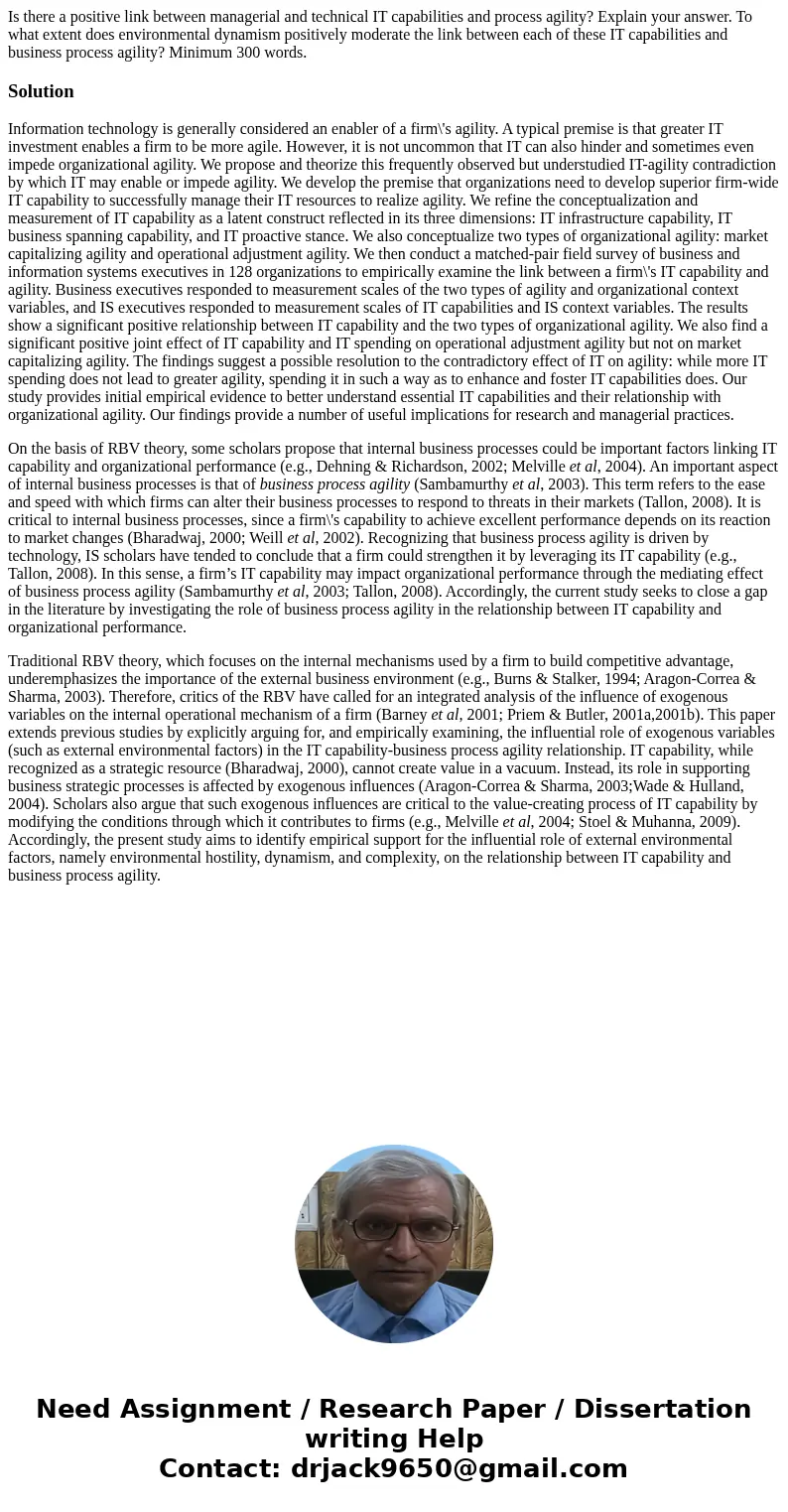Is there a positive link between managerial and technical IT
Is there a positive link between managerial and technical IT capabilities and process agility? Explain your answer. To what extent does environmental dynamism positively moderate the link between each of these IT capabilities and business process agility? Minimum 300 words.
Solution
Information technology is generally considered an enabler of a firm\'s agility. A typical premise is that greater IT investment enables a firm to be more agile. However, it is not uncommon that IT can also hinder and sometimes even impede organizational agility. We propose and theorize this frequently observed but understudied IT-agility contradiction by which IT may enable or impede agility. We develop the premise that organizations need to develop superior firm-wide IT capability to successfully manage their IT resources to realize agility. We refine the conceptualization and measurement of IT capability as a latent construct reflected in its three dimensions: IT infrastructure capability, IT business spanning capability, and IT proactive stance. We also conceptualize two types of organizational agility: market capitalizing agility and operational adjustment agility. We then conduct a matched-pair field survey of business and information systems executives in 128 organizations to empirically examine the link between a firm\'s IT capability and agility. Business executives responded to measurement scales of the two types of agility and organizational context variables, and IS executives responded to measurement scales of IT capabilities and IS context variables. The results show a significant positive relationship between IT capability and the two types of organizational agility. We also find a significant positive joint effect of IT capability and IT spending on operational adjustment agility but not on market capitalizing agility. The findings suggest a possible resolution to the contradictory effect of IT on agility: while more IT spending does not lead to greater agility, spending it in such a way as to enhance and foster IT capabilities does. Our study provides initial empirical evidence to better understand essential IT capabilities and their relationship with organizational agility. Our findings provide a number of useful implications for research and managerial practices.
On the basis of RBV theory, some scholars propose that internal business processes could be important factors linking IT capability and organizational performance (e.g., Dehning & Richardson, 2002; Melville et al, 2004). An important aspect of internal business processes is that of business process agility (Sambamurthy et al, 2003). This term refers to the ease and speed with which firms can alter their business processes to respond to threats in their markets (Tallon, 2008). It is critical to internal business processes, since a firm\'s capability to achieve excellent performance depends on its reaction to market changes (Bharadwaj, 2000; Weill et al, 2002). Recognizing that business process agility is driven by technology, IS scholars have tended to conclude that a firm could strengthen it by leveraging its IT capability (e.g., Tallon, 2008). In this sense, a firm’s IT capability may impact organizational performance through the mediating effect of business process agility (Sambamurthy et al, 2003; Tallon, 2008). Accordingly, the current study seeks to close a gap in the literature by investigating the role of business process agility in the relationship between IT capability and organizational performance.
Traditional RBV theory, which focuses on the internal mechanisms used by a firm to build competitive advantage, underemphasizes the importance of the external business environment (e.g., Burns & Stalker, 1994; Aragon-Correa & Sharma, 2003). Therefore, critics of the RBV have called for an integrated analysis of the influence of exogenous variables on the internal operational mechanism of a firm (Barney et al, 2001; Priem & Butler, 2001a,2001b). This paper extends previous studies by explicitly arguing for, and empirically examining, the influential role of exogenous variables (such as external environmental factors) in the IT capability-business process agility relationship. IT capability, while recognized as a strategic resource (Bharadwaj, 2000), cannot create value in a vacuum. Instead, its role in supporting business strategic processes is affected by exogenous influences (Aragon-Correa & Sharma, 2003;Wade & Hulland, 2004). Scholars also argue that such exogenous influences are critical to the value-creating process of IT capability by modifying the conditions through which it contributes to firms (e.g., Melville et al, 2004; Stoel & Muhanna, 2009). Accordingly, the present study aims to identify empirical support for the influential role of external environmental factors, namely environmental hostility, dynamism, and complexity, on the relationship between IT capability and business process agility.

 Homework Sourse
Homework Sourse